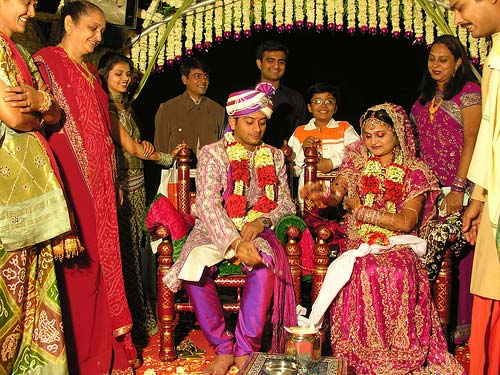Survey: Hindus Have the Lowest Divorce Rate in USA
By Aziz Haniffa | Фев 28, 2008

Not only are the Hindus and Mormons the most likely to be married (78 percent and 71 percent respectively), but also the most likely to be married to someone within their own faith (90 percent and 83 percent respectively), a landmark survey that details the religious affiliation of the American public and explores the remarkable dynamism taking place in the US religious marketplace has found.
The study, titled the U.S. Religious Landscape Survey, released on Monday by the Pew Forum on Religion & Public Life, also found that Hindus also have the lowest divorce rate of any group –only 5 percent have been divorced.
It also noted that nearly half of Hindus in the US, one-third of Jews and a quarter of Buddhists have obtained postgraduate education, compared with only about one-in-10 of the adult population overall.
The survey that was based on interviews conducted in English and Spanish with a nationally representative sample of over 35,000 adults, and includes detailed information on religious affiliation and provides estimates of the size of religious groups that are as small as three-tenth of 1 percent of the population, also found that Hindus and Jews are much more likely than other groups to report high income levels.
More than four in 10 of Hindus and Jews (43 percent and 46 percent respectively) made more than $100,000 per year.
In sharp contrast to Hinduism and Islam, Buddhism in the US is primarily made up of native-born adherents, whites and converts, and only one-in-three American Buddhists describe their race as Asian, and three-in-four Buddhists say they are converts to Buddhism,it said.
The survey also found that Mormons and Muslims are the groups with the largest families with more than one-in-five Mormon and 15 percent of Muslim adults in the US having three or more children living at home.
Hindus were less likely than other traditions to have no children living at home (52 percent), but compared with Muslims and Mormons, “they are more likely to have smaller families, with only a small number (3 percent) having three or more children at home’, the study said.
Luis Lugo, director of the Pew Forum, said, “People will be surprised by the amount of movement by Americans from one religious group to another– or to no religion at all. They’ll also be surprised by the extent to which immigration is helping to reshape the US religious landscape.”
Greg Smith, Research Fellow at the Pew Forum, who along with John Green, Senior Fellow at the Forum, and Lugo who participated in a teleconference with reporters, said the features and methodological strengths of the project revealed “some fascinating details about the demographics of a variety of religious groups”.
“We find that for instance, Hindus, stand out compared with other religious groups for their extraordinary high levels of educational attainment,” he said, and pointed out that “nearly half of Hindus in the United States–48 percent–have obtained postgraduate education over and above earning a college degree.”
Smith said, “That means that more than four times as many Hindus have reached this educational level as compared with the public overall.”
With regard to nativity by religious tradition, when the survey breaks down the various religious traditions by nationality, it found that Hindus, Muslims and members of Orthodox churches were the groups most heavily comprised of immigrants–86 percent, 65 percent and 38 percent of these groups, respectively, were born in another country.
Lugo predicted that “every indication is that adherence of these other world religions, such as Islam, Buddhism and Hinduism, will continue to grow as a percentage of the US population.”
He said that when the Census Bureau took its own numbers back in the mid-1950s, “all these groups were virtually a rounding error. So clearly they are growing and we know that you don’t need a high percentage of folks who are new of different as perceived by most folks in society to generate a lot of conversation, not least in politics and how do we accommodate the increasing diversity”.
Lugo said that “even 5 percent folks from these other world religions, which to most Americans are very new and very strange, generates a significant challenge for the country to begin to expand the process of accommodating beyond the categories that are most comfortable with–Protestant, Catholic and Jew”.















